Macroeconomics Assignment 08: Money, Wages, and Economic Models
VerifiedAdded on 2019/09/20
|8
|1960
|478
Homework Assignment
AI Summary
This assignment solution for a macroeconomics course, likely at the undergraduate level, delves into core macroeconomic principles. The first part examines the money multiplier, explaining why its real-world value is smaller than theoretical calculations and why depositing cash doesn't change the money supply. The second part contrasts Keynesian and Classical economic views regarding wage and price flexibility, particularly in the short and long run, respectively. The assignment also analyzes the transition from a recession to full employment using graphical representations of the money market, investment expenditure, and aggregate supply, illustrating the effects of interest rate changes and wage adjustments. The student references several economics textbooks and articles to support their analysis.
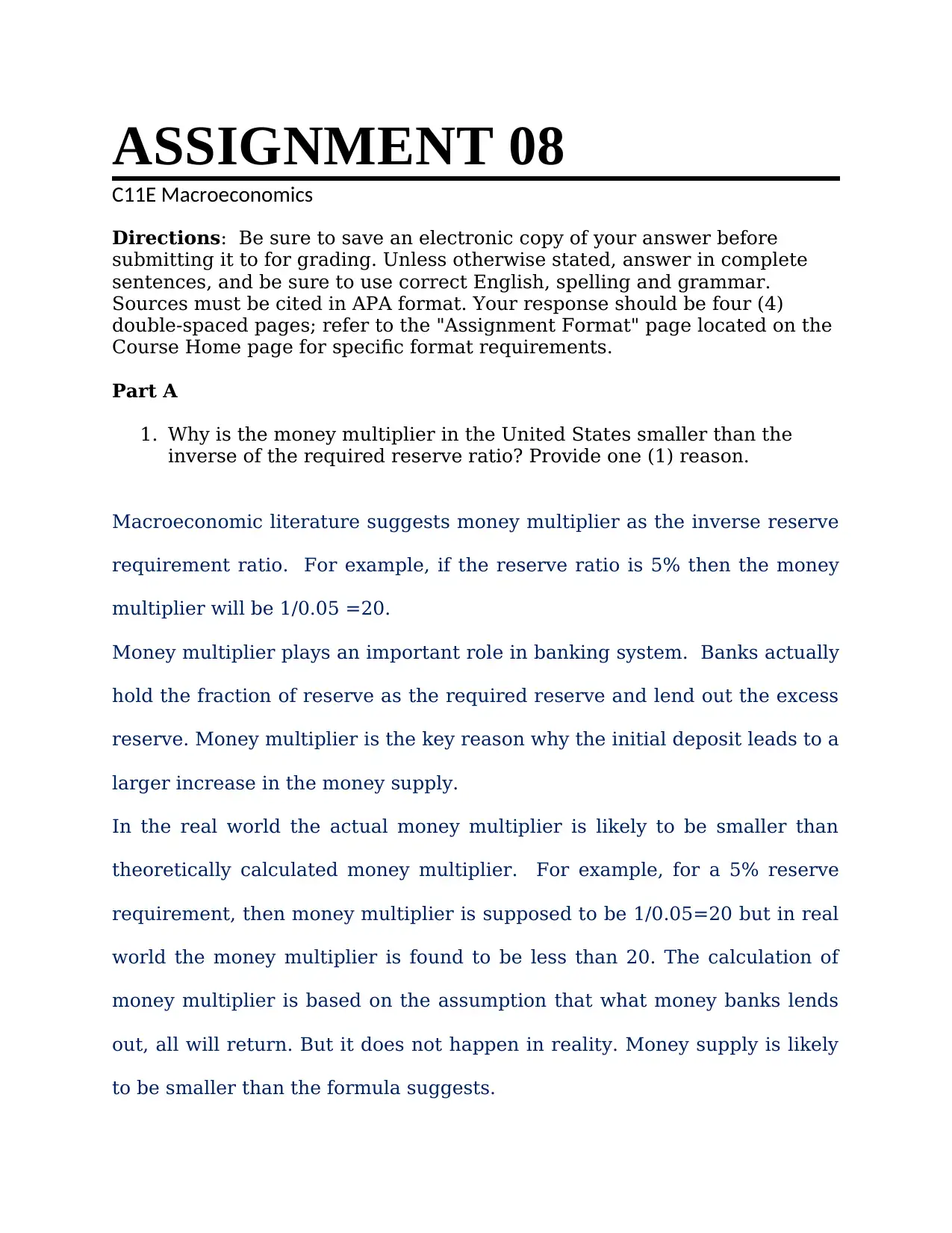
ASSIGNMENT 08
C11E Macroeconomics
Directions: Be sure to save an electronic copy of your answer before
submitting it to for grading. Unless otherwise stated, answer in complete
sentences, and be sure to use correct English, spelling and grammar.
Sources must be cited in APA format. Your response should be four (4)
double-spaced pages; refer to the "Assignment Format" page located on the
Course Home page for specific format requirements.
Part A
1. Why is the money multiplier in the United States smaller than the
inverse of the required reserve ratio? Provide one (1) reason.
Macroeconomic literature suggests money multiplier as the inverse reserve
requirement ratio. For example, if the reserve ratio is 5% then the money
multiplier will be 1/0.05 =20.
Money multiplier plays an important role in banking system. Banks actually
hold the fraction of reserve as the required reserve and lend out the excess
reserve. Money multiplier is the key reason why the initial deposit leads to a
larger increase in the money supply.
In the real world the actual money multiplier is likely to be smaller than
theoretically calculated money multiplier. For example, for a 5% reserve
requirement, then money multiplier is supposed to be 1/0.05=20 but in real
world the money multiplier is found to be less than 20. The calculation of
money multiplier is based on the assumption that what money banks lends
out, all will return. But it does not happen in reality. Money supply is likely
to be smaller than the formula suggests.
C11E Macroeconomics
Directions: Be sure to save an electronic copy of your answer before
submitting it to for grading. Unless otherwise stated, answer in complete
sentences, and be sure to use correct English, spelling and grammar.
Sources must be cited in APA format. Your response should be four (4)
double-spaced pages; refer to the "Assignment Format" page located on the
Course Home page for specific format requirements.
Part A
1. Why is the money multiplier in the United States smaller than the
inverse of the required reserve ratio? Provide one (1) reason.
Macroeconomic literature suggests money multiplier as the inverse reserve
requirement ratio. For example, if the reserve ratio is 5% then the money
multiplier will be 1/0.05 =20.
Money multiplier plays an important role in banking system. Banks actually
hold the fraction of reserve as the required reserve and lend out the excess
reserve. Money multiplier is the key reason why the initial deposit leads to a
larger increase in the money supply.
In the real world the actual money multiplier is likely to be smaller than
theoretically calculated money multiplier. For example, for a 5% reserve
requirement, then money multiplier is supposed to be 1/0.05=20 but in real
world the money multiplier is found to be less than 20. The calculation of
money multiplier is based on the assumption that what money banks lends
out, all will return. But it does not happen in reality. Money supply is likely
to be smaller than the formula suggests.
Paraphrase This Document
Need a fresh take? Get an instant paraphrase of this document with our AI Paraphraser
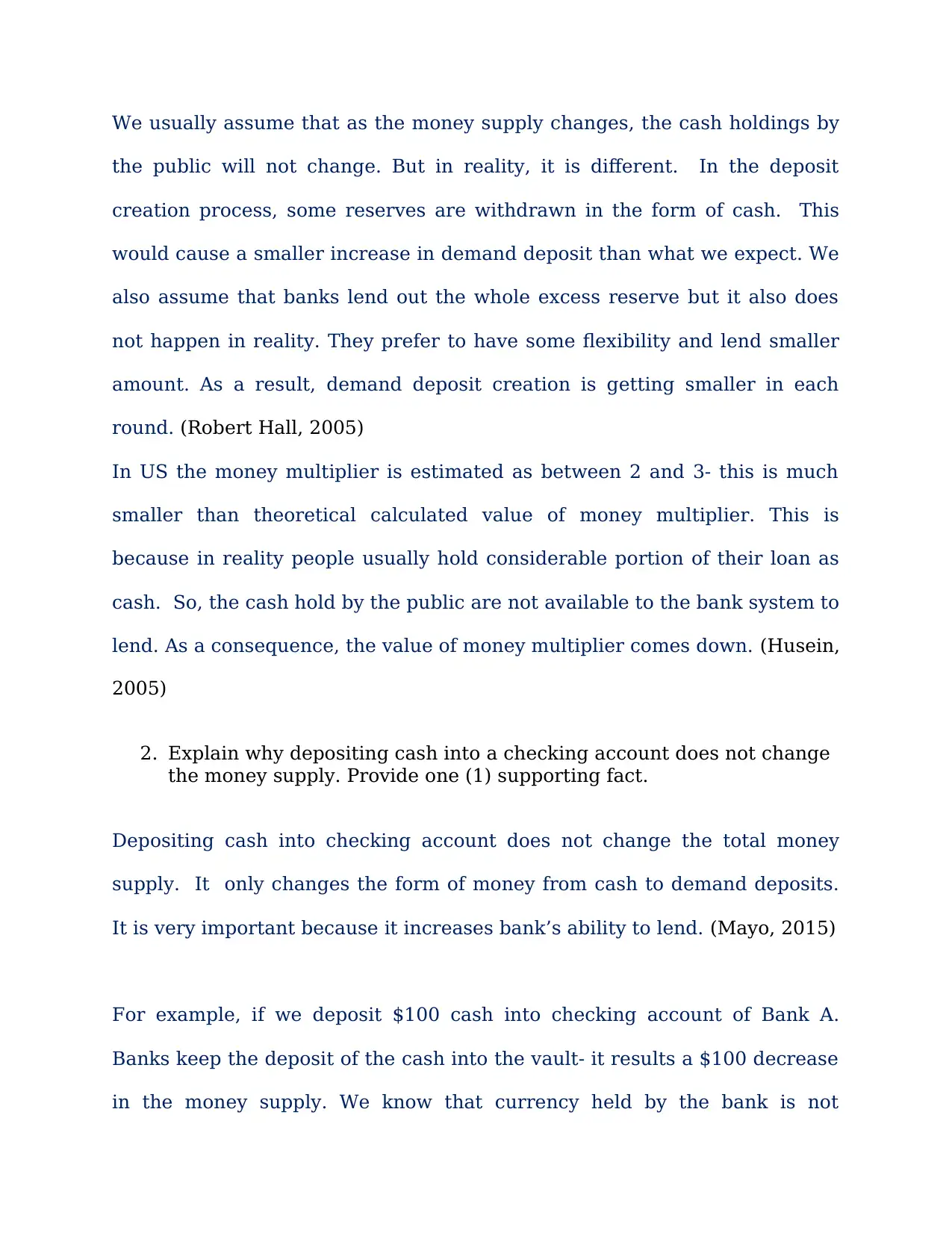
We usually assume that as the money supply changes, the cash holdings by
the public will not change. But in reality, it is different. In the deposit
creation process, some reserves are withdrawn in the form of cash. This
would cause a smaller increase in demand deposit than what we expect. We
also assume that banks lend out the whole excess reserve but it also does
not happen in reality. They prefer to have some flexibility and lend smaller
amount. As a result, demand deposit creation is getting smaller in each
round. (Robert Hall, 2005)
In US the money multiplier is estimated as between 2 and 3- this is much
smaller than theoretical calculated value of money multiplier. This is
because in reality people usually hold considerable portion of their loan as
cash. So, the cash hold by the public are not available to the bank system to
lend. As a consequence, the value of money multiplier comes down. (Husein,
2005)
2. Explain why depositing cash into a checking account does not change
the money supply. Provide one (1) supporting fact.
Depositing cash into checking account does not change the total money
supply. It only changes the form of money from cash to demand deposits.
It is very important because it increases bank’s ability to lend. (Mayo, 2015)
For example, if we deposit $100 cash into checking account of Bank A.
Banks keep the deposit of the cash into the vault- it results a $100 decrease
in the money supply. We know that currency held by the bank is not
the public will not change. But in reality, it is different. In the deposit
creation process, some reserves are withdrawn in the form of cash. This
would cause a smaller increase in demand deposit than what we expect. We
also assume that banks lend out the whole excess reserve but it also does
not happen in reality. They prefer to have some flexibility and lend smaller
amount. As a result, demand deposit creation is getting smaller in each
round. (Robert Hall, 2005)
In US the money multiplier is estimated as between 2 and 3- this is much
smaller than theoretical calculated value of money multiplier. This is
because in reality people usually hold considerable portion of their loan as
cash. So, the cash hold by the public are not available to the bank system to
lend. As a consequence, the value of money multiplier comes down. (Husein,
2005)
2. Explain why depositing cash into a checking account does not change
the money supply. Provide one (1) supporting fact.
Depositing cash into checking account does not change the total money
supply. It only changes the form of money from cash to demand deposits.
It is very important because it increases bank’s ability to lend. (Mayo, 2015)
For example, if we deposit $100 cash into checking account of Bank A.
Banks keep the deposit of the cash into the vault- it results a $100 decrease
in the money supply. We know that currency held by the bank is not
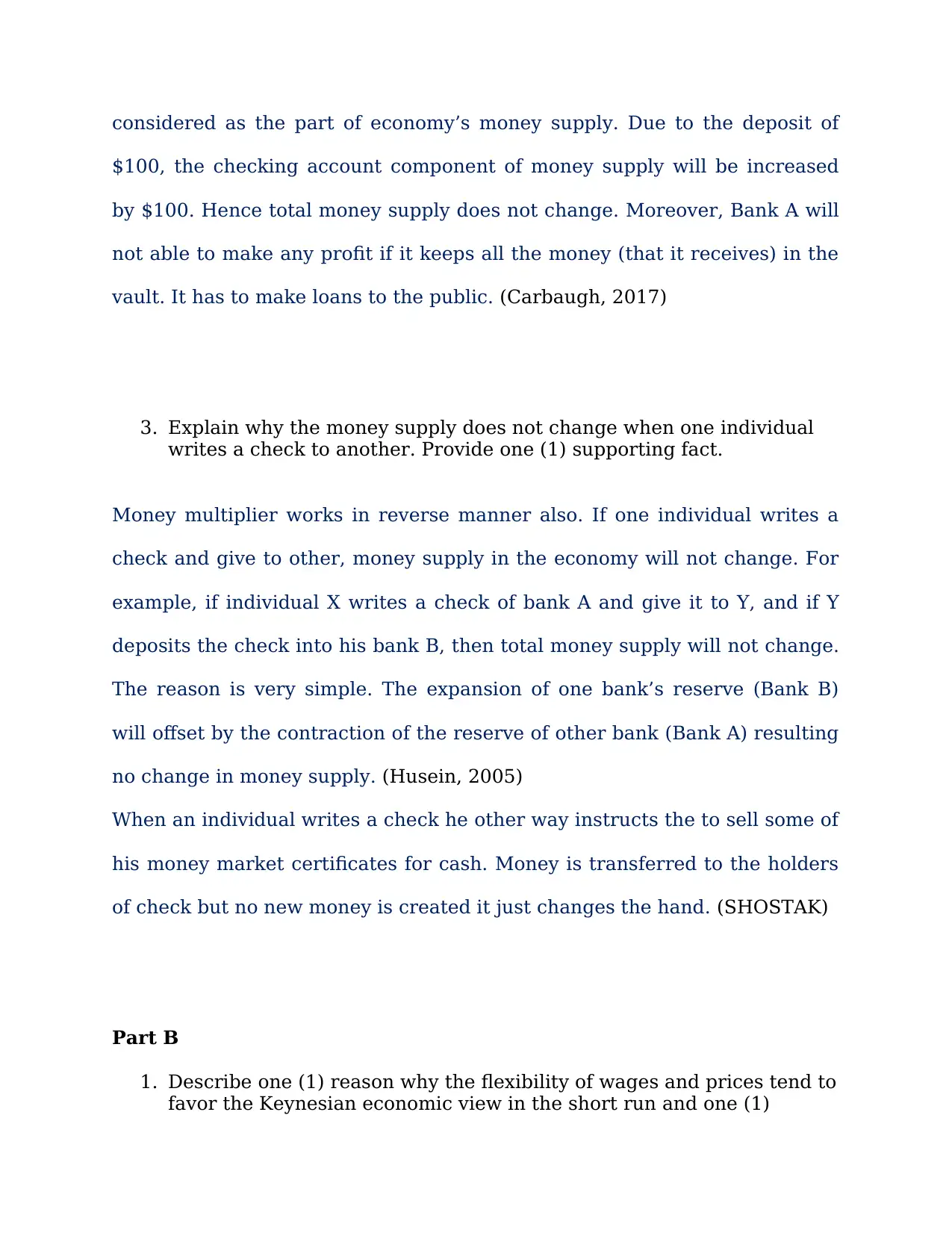
considered as the part of economy’s money supply. Due to the deposit of
$100, the checking account component of money supply will be increased
by $100. Hence total money supply does not change. Moreover, Bank A will
not able to make any profit if it keeps all the money (that it receives) in the
vault. It has to make loans to the public. (Carbaugh, 2017)
3. Explain why the money supply does not change when one individual
writes a check to another. Provide one (1) supporting fact.
Money multiplier works in reverse manner also. If one individual writes a
check and give to other, money supply in the economy will not change. For
example, if individual X writes a check of bank A and give it to Y, and if Y
deposits the check into his bank B, then total money supply will not change.
The reason is very simple. The expansion of one bank’s reserve (Bank B)
will offset by the contraction of the reserve of other bank (Bank A) resulting
no change in money supply. (Husein, 2005)
When an individual writes a check he other way instructs the to sell some of
his money market certificates for cash. Money is transferred to the holders
of check but no new money is created it just changes the hand. (SHOSTAK)
Part B
1. Describe one (1) reason why the flexibility of wages and prices tend to
favor the Keynesian economic view in the short run and one (1)
$100, the checking account component of money supply will be increased
by $100. Hence total money supply does not change. Moreover, Bank A will
not able to make any profit if it keeps all the money (that it receives) in the
vault. It has to make loans to the public. (Carbaugh, 2017)
3. Explain why the money supply does not change when one individual
writes a check to another. Provide one (1) supporting fact.
Money multiplier works in reverse manner also. If one individual writes a
check and give to other, money supply in the economy will not change. For
example, if individual X writes a check of bank A and give it to Y, and if Y
deposits the check into his bank B, then total money supply will not change.
The reason is very simple. The expansion of one bank’s reserve (Bank B)
will offset by the contraction of the reserve of other bank (Bank A) resulting
no change in money supply. (Husein, 2005)
When an individual writes a check he other way instructs the to sell some of
his money market certificates for cash. Money is transferred to the holders
of check but no new money is created it just changes the hand. (SHOSTAK)
Part B
1. Describe one (1) reason why the flexibility of wages and prices tend to
favor the Keynesian economic view in the short run and one (1)
⊘ This is a preview!⊘
Do you want full access?
Subscribe today to unlock all pages.

Trusted by 1+ million students worldwide
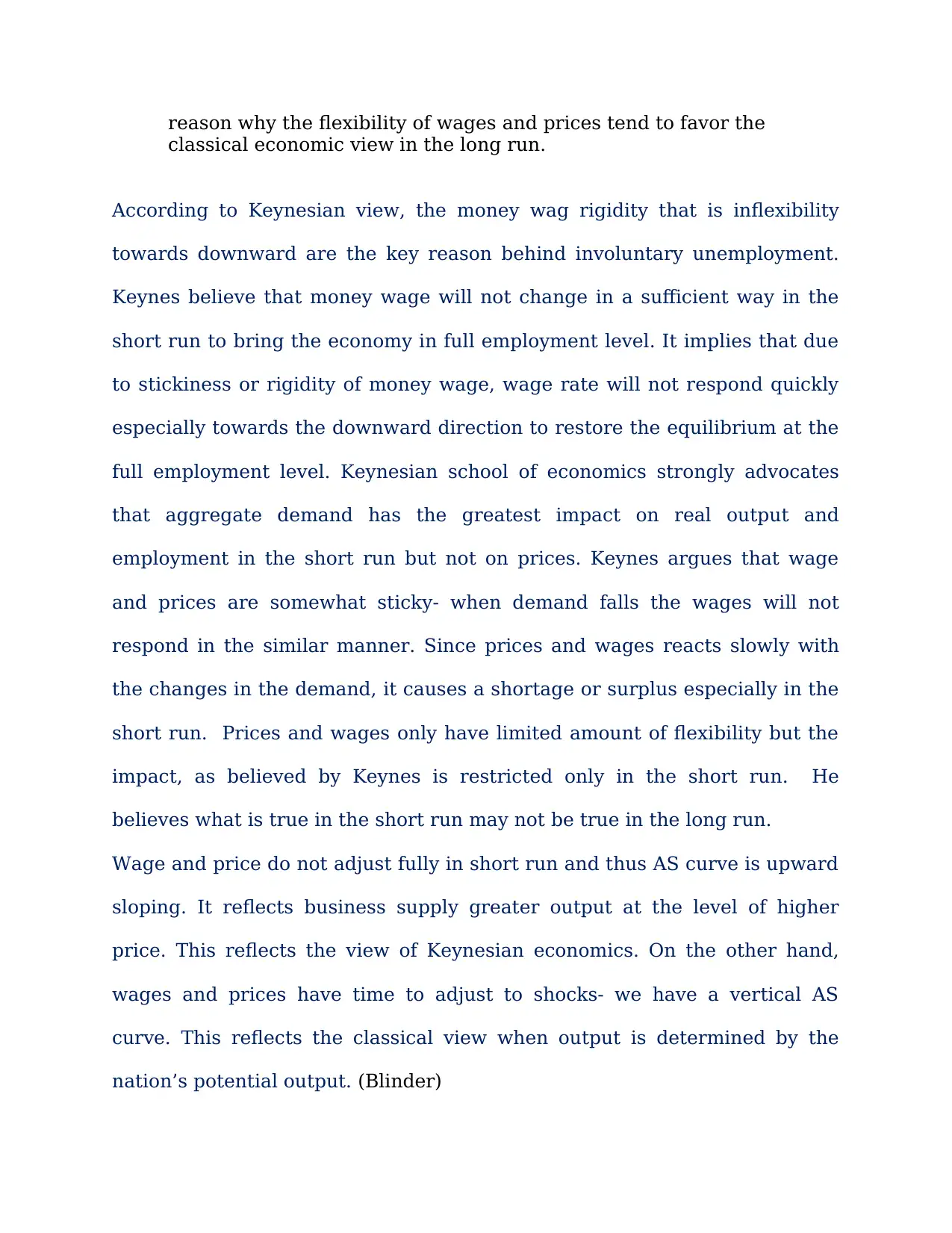
reason why the flexibility of wages and prices tend to favor the
classical economic view in the long run.
According to Keynesian view, the money wag rigidity that is inflexibility
towards downward are the key reason behind involuntary unemployment.
Keynes believe that money wage will not change in a sufficient way in the
short run to bring the economy in full employment level. It implies that due
to stickiness or rigidity of money wage, wage rate will not respond quickly
especially towards the downward direction to restore the equilibrium at the
full employment level. Keynesian school of economics strongly advocates
that aggregate demand has the greatest impact on real output and
employment in the short run but not on prices. Keynes argues that wage
and prices are somewhat sticky- when demand falls the wages will not
respond in the similar manner. Since prices and wages reacts slowly with
the changes in the demand, it causes a shortage or surplus especially in the
short run. Prices and wages only have limited amount of flexibility but the
impact, as believed by Keynes is restricted only in the short run. He
believes what is true in the short run may not be true in the long run.
Wage and price do not adjust fully in short run and thus AS curve is upward
sloping. It reflects business supply greater output at the level of higher
price. This reflects the view of Keynesian economics. On the other hand,
wages and prices have time to adjust to shocks- we have a vertical AS
curve. This reflects the classical view when output is determined by the
nation’s potential output. (Blinder)
classical economic view in the long run.
According to Keynesian view, the money wag rigidity that is inflexibility
towards downward are the key reason behind involuntary unemployment.
Keynes believe that money wage will not change in a sufficient way in the
short run to bring the economy in full employment level. It implies that due
to stickiness or rigidity of money wage, wage rate will not respond quickly
especially towards the downward direction to restore the equilibrium at the
full employment level. Keynesian school of economics strongly advocates
that aggregate demand has the greatest impact on real output and
employment in the short run but not on prices. Keynes argues that wage
and prices are somewhat sticky- when demand falls the wages will not
respond in the similar manner. Since prices and wages reacts slowly with
the changes in the demand, it causes a shortage or surplus especially in the
short run. Prices and wages only have limited amount of flexibility but the
impact, as believed by Keynes is restricted only in the short run. He
believes what is true in the short run may not be true in the long run.
Wage and price do not adjust fully in short run and thus AS curve is upward
sloping. It reflects business supply greater output at the level of higher
price. This reflects the view of Keynesian economics. On the other hand,
wages and prices have time to adjust to shocks- we have a vertical AS
curve. This reflects the classical view when output is determined by the
nation’s potential output. (Blinder)
Paraphrase This Document
Need a fresh take? Get an instant paraphrase of this document with our AI Paraphraser
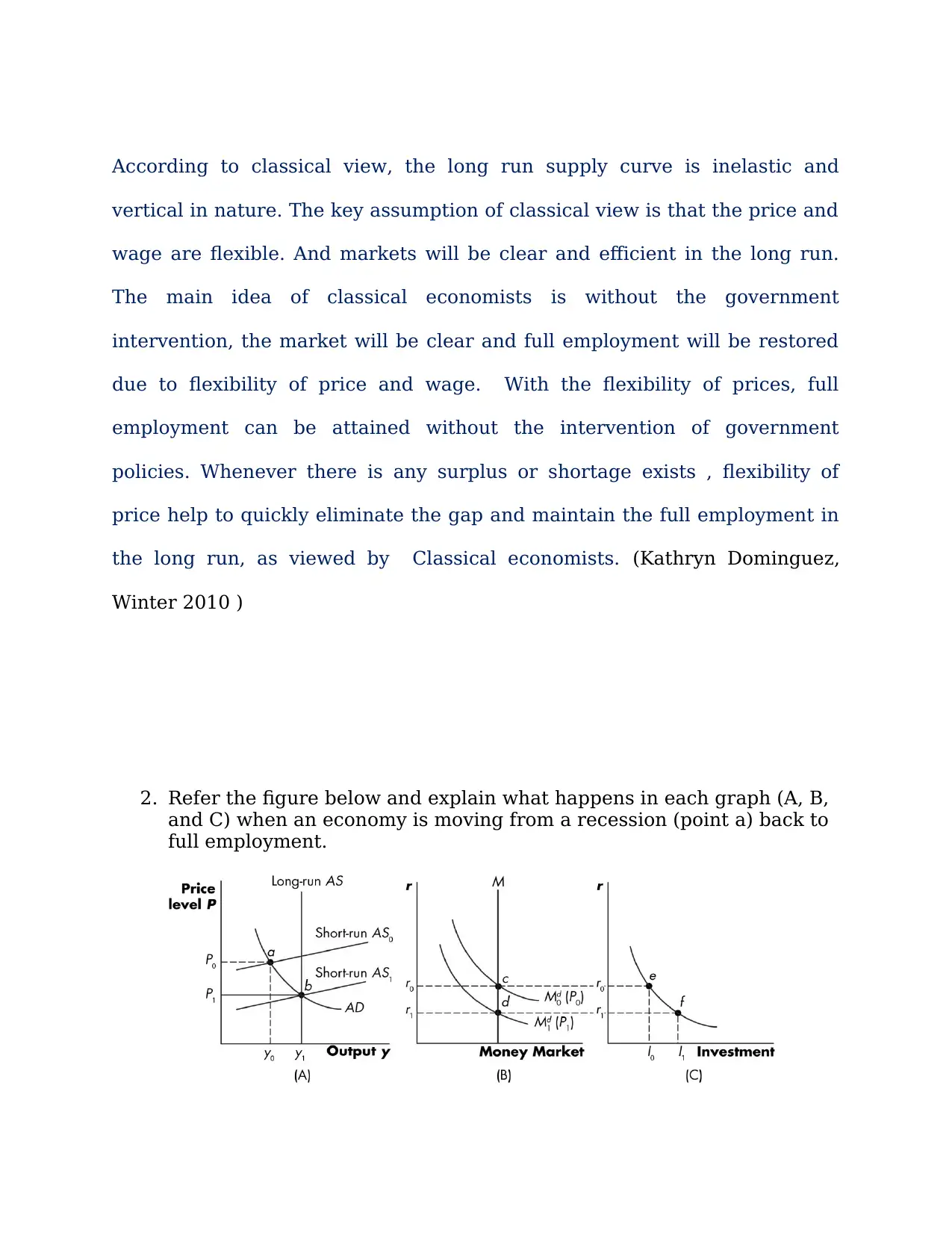
According to classical view, the long run supply curve is inelastic and
vertical in nature. The key assumption of classical view is that the price and
wage are flexible. And markets will be clear and efficient in the long run.
The main idea of classical economists is without the government
intervention, the market will be clear and full employment will be restored
due to flexibility of price and wage. With the flexibility of prices, full
employment can be attained without the intervention of government
policies. Whenever there is any surplus or shortage exists , flexibility of
price help to quickly eliminate the gap and maintain the full employment in
the long run, as viewed by Classical economists. (Kathryn Dominguez,
Winter 2010 )
2. Refer the figure below and explain what happens in each graph (A, B,
and C) when an economy is moving from a recession (point a) back to
full employment.
vertical in nature. The key assumption of classical view is that the price and
wage are flexible. And markets will be clear and efficient in the long run.
The main idea of classical economists is without the government
intervention, the market will be clear and full employment will be restored
due to flexibility of price and wage. With the flexibility of prices, full
employment can be attained without the intervention of government
policies. Whenever there is any surplus or shortage exists , flexibility of
price help to quickly eliminate the gap and maintain the full employment in
the long run, as viewed by Classical economists. (Kathryn Dominguez,
Winter 2010 )
2. Refer the figure below and explain what happens in each graph (A, B,
and C) when an economy is moving from a recession (point a) back to
full employment.
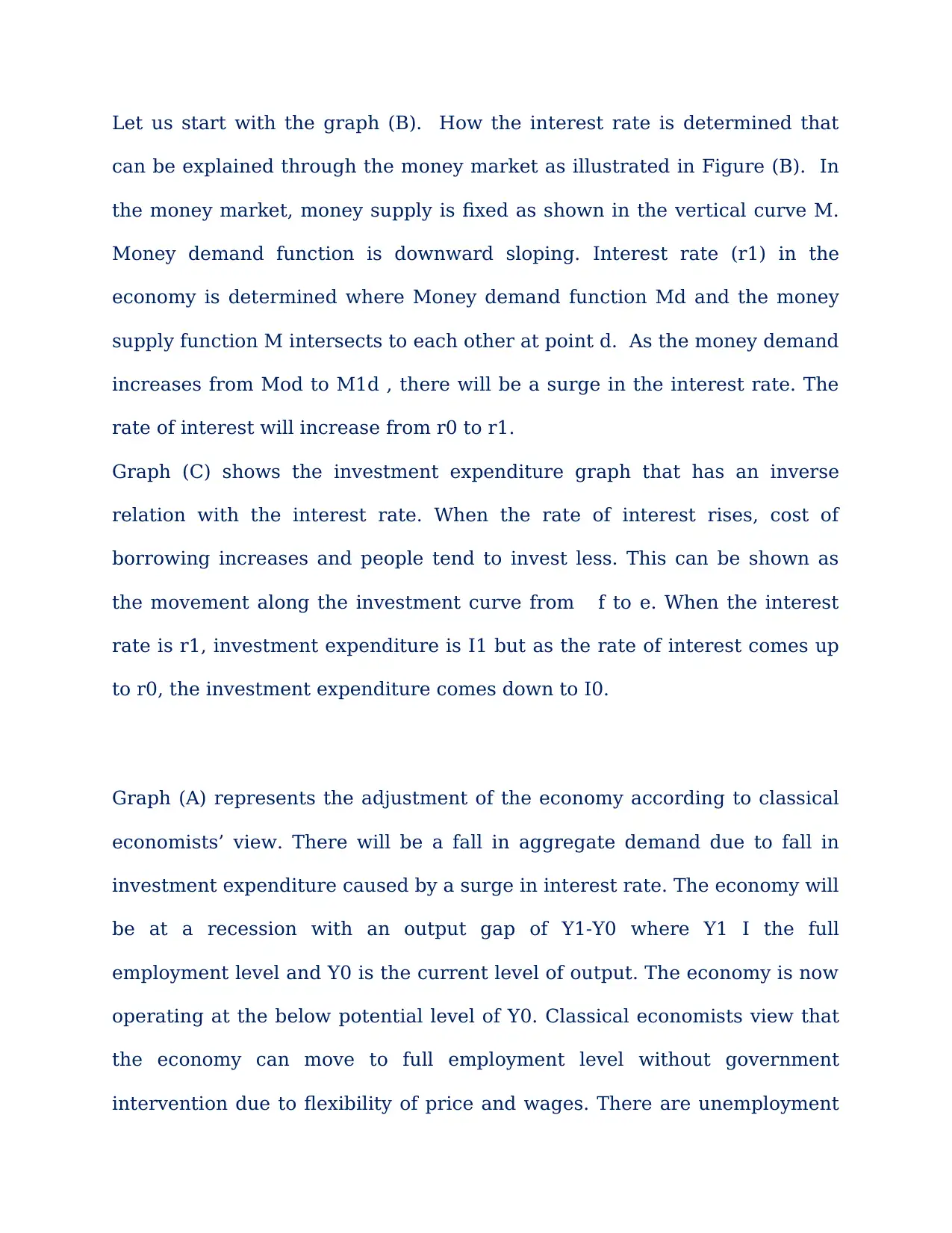
Let us start with the graph (B). How the interest rate is determined that
can be explained through the money market as illustrated in Figure (B). In
the money market, money supply is fixed as shown in the vertical curve M.
Money demand function is downward sloping. Interest rate (r1) in the
economy is determined where Money demand function Md and the money
supply function M intersects to each other at point d. As the money demand
increases from Mod to M1d , there will be a surge in the interest rate. The
rate of interest will increase from r0 to r1.
Graph (C) shows the investment expenditure graph that has an inverse
relation with the interest rate. When the rate of interest rises, cost of
borrowing increases and people tend to invest less. This can be shown as
the movement along the investment curve from f to e. When the interest
rate is r1, investment expenditure is I1 but as the rate of interest comes up
to r0, the investment expenditure comes down to I0.
Graph (A) represents the adjustment of the economy according to classical
economists’ view. There will be a fall in aggregate demand due to fall in
investment expenditure caused by a surge in interest rate. The economy will
be at a recession with an output gap of Y1-Y0 where Y1 I the full
employment level and Y0 is the current level of output. The economy is now
operating at the below potential level of Y0. Classical economists view that
the economy can move to full employment level without government
intervention due to flexibility of price and wages. There are unemployment
can be explained through the money market as illustrated in Figure (B). In
the money market, money supply is fixed as shown in the vertical curve M.
Money demand function is downward sloping. Interest rate (r1) in the
economy is determined where Money demand function Md and the money
supply function M intersects to each other at point d. As the money demand
increases from Mod to M1d , there will be a surge in the interest rate. The
rate of interest will increase from r0 to r1.
Graph (C) shows the investment expenditure graph that has an inverse
relation with the interest rate. When the rate of interest rises, cost of
borrowing increases and people tend to invest less. This can be shown as
the movement along the investment curve from f to e. When the interest
rate is r1, investment expenditure is I1 but as the rate of interest comes up
to r0, the investment expenditure comes down to I0.
Graph (A) represents the adjustment of the economy according to classical
economists’ view. There will be a fall in aggregate demand due to fall in
investment expenditure caused by a surge in interest rate. The economy will
be at a recession with an output gap of Y1-Y0 where Y1 I the full
employment level and Y0 is the current level of output. The economy is now
operating at the below potential level of Y0. Classical economists view that
the economy can move to full employment level without government
intervention due to flexibility of price and wages. There are unemployment
⊘ This is a preview!⊘
Do you want full access?
Subscribe today to unlock all pages.

Trusted by 1+ million students worldwide

resources because the economy is now operating at the below potential
level. According to the classical economist prediction when there are
unemployed resources, the price paid to the resources (wages) will fall.
With a lower wage than before, the suppliers are now able to supply more
at the lower cost that would shift the AS curve to the right. As a result, AS
curve will shift from AS0 to AS1 in the short run. The price level will fall
from P0 to P1 but the economy will again back to the point b , at the
natural level with the potential output of Y1. (CliffNotes, 2016)
References
Blinder, A. S. (n.d.). Keynesian Economics. Retrieved from econolib:
http://www.econlib.org/library/Enc/KeynesianEconomics.html
Carbaugh, R. (2017). Contemporary Economics: An Applications Approach. New York: Routledge.
CliffNotes. (2016). The Classical Theory. Retrieved from CliffNotes : https://www.cliffsnotes.com/study-
guides/economics/classical-and-keynesian-theories-output-employment/the-classical-theory
Husein, J. (2005). Money, the Banking System, and The Federal Reserve . Retrieved from
https://www.csun.edu/sites/default/files/macro6_0.pdf
level. According to the classical economist prediction when there are
unemployed resources, the price paid to the resources (wages) will fall.
With a lower wage than before, the suppliers are now able to supply more
at the lower cost that would shift the AS curve to the right. As a result, AS
curve will shift from AS0 to AS1 in the short run. The price level will fall
from P0 to P1 but the economy will again back to the point b , at the
natural level with the potential output of Y1. (CliffNotes, 2016)
References
Blinder, A. S. (n.d.). Keynesian Economics. Retrieved from econolib:
http://www.econlib.org/library/Enc/KeynesianEconomics.html
Carbaugh, R. (2017). Contemporary Economics: An Applications Approach. New York: Routledge.
CliffNotes. (2016). The Classical Theory. Retrieved from CliffNotes : https://www.cliffsnotes.com/study-
guides/economics/classical-and-keynesian-theories-output-employment/the-classical-theory
Husein, J. (2005). Money, the Banking System, and The Federal Reserve . Retrieved from
https://www.csun.edu/sites/default/files/macro6_0.pdf
Paraphrase This Document
Need a fresh take? Get an instant paraphrase of this document with our AI Paraphraser
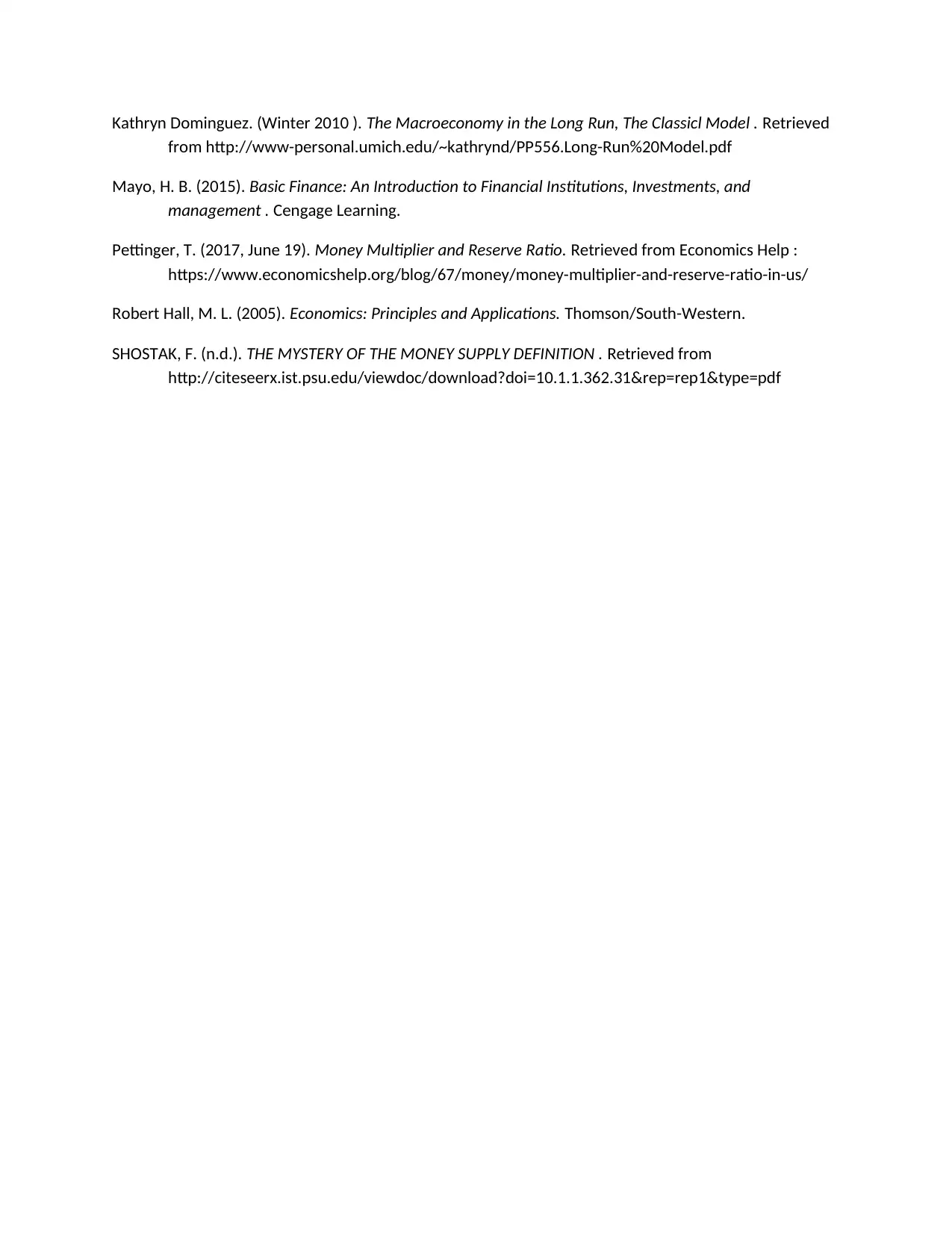
Kathryn Dominguez. (Winter 2010 ). The Macroeconomy in the Long Run, The Classicl Model . Retrieved
from http://www-personal.umich.edu/~kathrynd/PP556.Long-Run%20Model.pdf
Mayo, H. B. (2015). Basic Finance: An Introduction to Financial Institutions, Investments, and
management . Cengage Learning.
Pettinger, T. (2017, June 19). Money Multiplier and Reserve Ratio. Retrieved from Economics Help :
https://www.economicshelp.org/blog/67/money/money-multiplier-and-reserve-ratio-in-us/
Robert Hall, M. L. (2005). Economics: Principles and Applications. Thomson/South-Western.
SHOSTAK, F. (n.d.). THE MYSTERY OF THE MONEY SUPPLY DEFINITION . Retrieved from
http://citeseerx.ist.psu.edu/viewdoc/download?doi=10.1.1.362.31&rep=rep1&type=pdf
from http://www-personal.umich.edu/~kathrynd/PP556.Long-Run%20Model.pdf
Mayo, H. B. (2015). Basic Finance: An Introduction to Financial Institutions, Investments, and
management . Cengage Learning.
Pettinger, T. (2017, June 19). Money Multiplier and Reserve Ratio. Retrieved from Economics Help :
https://www.economicshelp.org/blog/67/money/money-multiplier-and-reserve-ratio-in-us/
Robert Hall, M. L. (2005). Economics: Principles and Applications. Thomson/South-Western.
SHOSTAK, F. (n.d.). THE MYSTERY OF THE MONEY SUPPLY DEFINITION . Retrieved from
http://citeseerx.ist.psu.edu/viewdoc/download?doi=10.1.1.362.31&rep=rep1&type=pdf
1 out of 8
Related Documents
Your All-in-One AI-Powered Toolkit for Academic Success.
+13062052269
info@desklib.com
Available 24*7 on WhatsApp / Email
![[object Object]](/_next/static/media/star-bottom.7253800d.svg)
Unlock your academic potential
Copyright © 2020–2026 A2Z Services. All Rights Reserved. Developed and managed by ZUCOL.





